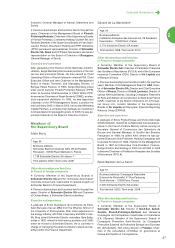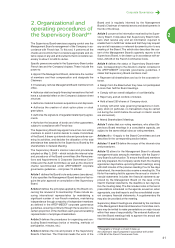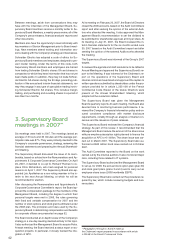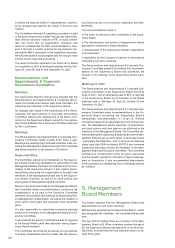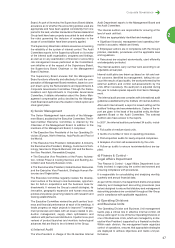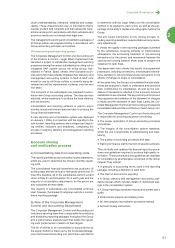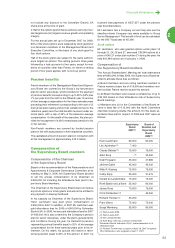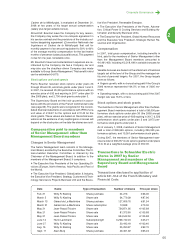APC 2007 Annual Report Download - page 49
Download and view the complete annual report
Please find page 49 of the 2007 APC annual report below. You can navigate through the pages in the report by either clicking on the pages listed below, or by using the keyword search tool below to find specific information within the annual report.
47
Corporate Governance
2
Board. As part of its review, the Supervisory Board obtains
assurance as to whether the accounting policies used are
appropriate and have been applied consistently from one
period to the next, whether transactions that are material at
Group level have been properly accounted for and whether
the rules governing the inclusion of companies in the
scope of consolidation have been properly applied.
The Supervisory Board also obtains assurance concerning
the reliability of the system of internal control. The Audit
Committee reports to the Supervisory Board on its review
of the internal audit organization, programs and findings,
as well as on any examination of financial or accounting
risk management issues performed at the Committee’s
own initiative or at the request of the Supervisory Board,
the Supervisory Board Chairman or the Management
Board Chairman.
The Supervisory Board ensures that the Management
Board functions efficiently and effectively. It sets the com-
pensation of Management Board members, based on a re-
port drawn up by the Remunerations and Appointments &
Corporate Governance Committee. Through the Remu-
nerations and Appointments & Corporate Governance
Committee, it obtains information about the Senior Man-
agement compensation policy decided by the Manage-
ment Board and authorizes the creation of stock option and
stock grant plans.
b) Senior Management
The Senior Management team consists of the Manage-
ment Board, assisted by the Executive Committee. The fif-
teen-member Executive Committee is chaired by the
Chairman of the Management Board. In addition to the
members of the Management Board, it comprises:
The Executive Vice Presidents of the four Operating Di-
visions (Europe, North America, Asia-Pacific and Rest of
the World).
The Executive Vice-President, Globalization & Industry,
the Executive Vice President, Strategy, Customers & Tech-
nology, Services & Projects Business Unit and the Execu-
tive Vice President, Renewable Energies.
The Executive Vice Presidents of the Power, Automa-
tion, Critical Power & Cooling Services and Building Au-
tomation and Security Business Units.
The Executive Vice President, Global Human Resources
and the Executive Vice President, Strategic Human Re-
sources and Organization.
The Executive Committee regularly reviews the develop-
ment outlook of the Group’s core businesses, opportuni-
ties for bolt-on acquisitions and the business case for
divestments. It reviews the Group’s overall strategies, its
innovation, geographic expansion and human resources
policies and policies governing relations with research and
training establishments.
The Executive Committee reviews the profit centers' busi-
ness and financial performance at each of its meetings. It
tracks progress on major projects to improve IT manage-
ment processes and deals with all issues related to pro-
duction management, supply chain optimization and
relations with partners and distributors. It performs ex-post
reviews of product launches and monitors technological
advances that are likely to be of interest to the Group.
c) Internal Audit
The Vice-President in charge of the 25-member Internal
Audit Department reports to the Management Board and
the Audit Committee.
The internal auditors are responsible for ensuring at the
level of each unit that:
Risks are appropriately identified and managed.
Significant financial, management and operating infor-
mation is accurate, reliable and timely.
Employees' actions are in compliance with the Group's
policies, standards, procedures and the applicable laws
and regulations.
Resources are acquired economically, used efficiently
and adequately protected.
The internal auditors carry out their work according to an
adjustable annual plan.
Internal audit plans are drawn up based on risk and con-
trol concerns identified by management, taking into ac-
count the results of past audits, the work performed by the
external auditors and control self-assessments by the
units. When necessary, the audit plan is adjusted during
the year to include special requests from Senior Manage-
ment.
The internal audit process complies with international audit
guidelines established by the Institute of Internal Auditors.
After each internal audit, a report is issued setting out the
auditors’ findings and recommendations. Copies of the re-
port are given to the head of the audited entity, the Man-
agement Board or the Audit Committee. The external
Auditors also have access to the reports.
In 2007, the internal auditors performed 34 audits, includ-
ing:
Full audits of medium-sized units.
Audits of a number of risks or operating processes.
Post-acquisition audits for newly acquired companies.
Analyses of control self-assessments by the units.
Follow-up audits to ensure recommendations are ap-
plied.
d) Finance & Control -
Legal Affairs Department
The Finance & Control - Legal Affairs Department is ac-
tively involved in organizing the control environment and
ensuring compliance with procedures.
It is responsible for consolidating and analyzing monthly,
quarterly and annual financial data.
As part of this mission, the department drafts and updates
statutory and management accounting procedures (see
below) designed to ensure that statutory and management
accounting practices are consistent throughout the Group
and in compliance with applicable regulations.
e) Operating Divisions
and Business Units
The Operating Division and Business Unit management
teams play a critical role in effective internal control. All
Group units report to one of the four Operating Divisions or
one of the Business Units, which are managed by an Ex-
ecutive Vice President, supported by a financial controller.
Within each division, the management team organizes
control of operations, ensures that appropriate strategies
are deployed to achieve objectives and tracks unit per-
formance.


